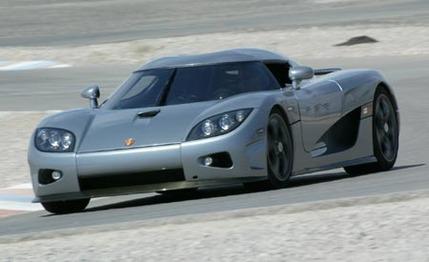
 Road Test
Road Test
The first thing you notice about Christian von Koenigsegg is that his eyebrows are gone, replaced by tattoos. After an inevitable double take, you realize the 29-year-old Swedish entrepreneur has no beard or eyelashes, either. Koenigsegg suffers from alopecia areata, an autoimmune disorder in which the body turns against its own hair follicles, a condition often brought on by prolonged stress.
Koenigsegg was asking for it. In 1994, he decided to get into the supercar business.
Yet Koenigsegg is serene-at least on the outside. "It's not true that everybody who gets into the business eventually folds," he says affably. "Look at Pagani, Mosler, Edonis, Saleen. It's about a 50-percent success rate, which is better than a lot of businesses."
Koenigsegg hopes his silver CC V-8 will unseat the legendary McLaren F1 as the world's fastest production car. On March 31, 1998, Andy Wallace piloted a McLaren F1 to 240.1 mph. No car has ever seriously challenged that record until now, and when you see Koenigsegg's headquarters-a 200-year-old thatched-roof farmhouse that looks as though Pippi Longstocking just moved out-you wonder how serious he is.
Mounted amidships under the car's double-humped bonnet, a 4.6-liter Ford 32-valve V-8 huffs 19 pounds of intercooled boost from a Paxton Novi supercharger. Koenigsegg claims 655 horsepower at 6500 rpm and 553 pound-feet of torque at 5000 rpm, divided by a curb weight of just 2800 pounds, for a weight-to-power ratio of 4.3 pounds per horsepower. The body's drag coefficient is 0.30, yet at 200 mph it manages to create 110 pounds of downforce in front and 154 in back.
The arithmetic says that with a final-drive ratio of 3.36:1, a redline of 7000 rpm, and 18-inch wheels, the car could conceivably top out at nearly 235 mph in fifth gear-within spitting distance of the McLaren's record.
Gordon Murray is skeptical. After an article on the CC appeared in the British car mag Evo, Murray, McLaren's technical director, wrote a dismissive, even derisive letter claiming the McLaren would never be surpassed, least of all by some upstart from Sweden. Koenigsegg treasures the letter.
We saddle up for a quick spin through the Neverland scenery around Ängelholm, in southern Sweden. The driver's door swivels up and forward on its marvelously engineered, multi-axis hinge and closes with the sound of a fastball finding the pocket of a catcher's mitt- whooompff. The car sweetly stutters into first gear, and we're soon gliding down a country two-lane, 100 mph in a lazy third gear. Koenigsegg gives me the "go" sign, and I roll into the throttle. An eye-rattling blur, a roar, my head tossed back into the headrest, the landscape geysering toward me in fauvist greens and yellows- oh, sweet Jesus!-and I grab fourth, wham! there goes my head again. The road shrinks to thread. I stretch for the 7000 redline, then jam the billet aluminum shifter northeast for fifth. Moments later, the car nears 200 mph, and it isn't even breathing hard. I am.
Christian von Koenigsegg was born in Stockholm in 1972, the son of a wealthy entrepreneur. The family name is German for "king's blade." The car bug bit Koenigsegg when he was three, after he saw an animated movie about a Norwegian bicycle repairman who builds a supercar for Le Mans. "I thought that was real," he says. "In the back of my mind I always had it that a bicycle repairman built this amazing car."
As a child, Koenigsegg (say, koh-neegs-egg) pored over stacks of car magazines. Much later, he took business and economics courses at the Scandinavian School of Brussels, always planning. "Building a car company was the only thing I studied with my whole heart."
In 1994, he began his first prototype in the family garage, using his own money. In 1995, Koenigsegg applied for-and much to his surprise, received-a loan of $150,000 from the Swedish Board for Technological Development.
Over the next two years, Koenigsegg developed a space-frame and composite prototype powered by a 4.2-liter Audi engine. He took the car to a BPR race in Anderstorp. Test driver Rickard Rydell lapped the circuit a second faster than the pole-sitting Lamborghini Diablo.